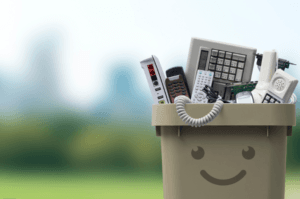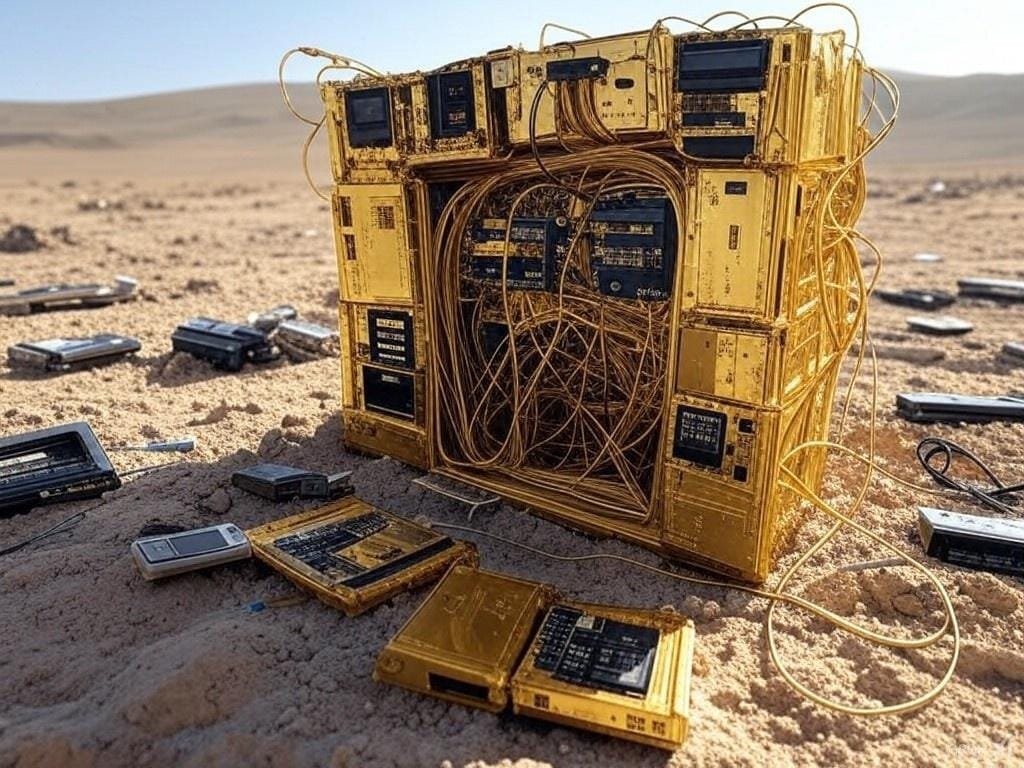Have you ever wondered if the junk drawer in your home, filled with old phones and broken gadgets, could hold more than sentimental value? What if it contained the potential to revolutionize sustainability, offering not just a solution for e-waste but also a golden opportunity for greener chemistry? This is no fantasy. Scientists are now transforming electronic waste into something precious—gold. But the real marvel lies not in the gold itself but in how it’s being used to tackle critical environmental challenges.
This pioneering research, led by Amin Zadehnazari introduces a new era of gold recycling. By transforming electronic waste into gold-loaded covalent organic framework (COF) catalysts, these scientists are redefining how we perceive e-waste.
The Golden Chemistry of Sustainability
Gold recycling, often referred to as “urban mining” has emerged as a sustainable alternative to the environmentally destructive methods of traditional mining. With approximately 25% of the world’s gold being recycled, discarded electronics like smartphones and laptops are proving to be treasure troves of this valuable metal. Electronic waste is a hidden gold mine, every ton of e-waste has 10 times more gold than of traditional. With around 80 metric tons of e-waste expected by 2030, it is very crucial to recover the economy from e-waste.
The method isn’t just about recovering gold; it’s about leveraging its remarkable properties for groundbreaking innovations, such as the development of advanced catalysts for chemical reactions. Gold’s unique affinity for nitrogen and sulfur ligands forms the basis of its fascinating role in modern science. One such ligand system is tetrathiafulvalene (TTF), a sulfur-rich compound with an exceptional ability to bind with gold. Researchers have recently taken this chemistry a step further. They paired TTF with tetrazine, a building block used to create vinyl-linked covalent organic frameworks (VCOFs). These frameworks are at the heart of an exciting innovation: gold-loaded covalent organic framework catalysts.

Researchers developed a pair of VCOFs to extract gold ions and nanoparticles from circuit boards in electronic wastes. One of his VCOFs efficiently captured 99% of the gold while leaving tiny amounts of other metals like nickel and copper largely unaffected
But why is this important? These catalysts are not just fancy laboratory novelties. They hold immense promise for one of today’s most pressing environmental challenges: reducing carbon dioxide (CO2) emissions. Imagine capturing CO2, a major greenhouse gas, and turning it into useful products through sustainable chemistry. Au-COFs can make that happen by facilitating the carboxylation of terminal alkynes, a chemical reaction that incorporates CO2 into organic molecules.
The Breakthrough in Materials: TTF-COF and TPE-COF
In their groundbreaking study, Zadehnazari, a postdoctoral researcher in the lab of Alireza Abbaspourradand, and his team synthesized two types of covalent organic frameworks: TTF-COF and TPE-COF. These materials were created by combining TTF and tetraphenylethylene (TPE) with 1,2,4,5-tetrazine using a Knoevenagel condensation reaction. Both COFs revealed highly organized pore networks with extraordinary surface areas (TTF-COF at 1743 m²/g and TPE-COF at 1840 m²/g).
The structural stability and electronic properties of these COFs were meticulously analyzed using advanced techniques like powder X-ray diffraction (PXRD), FT-IR spectroscopy, and cyclic voltammetry. Their design was more than a testament to scientific ingenuity; it was a gateway to unlocking their real-world applications.
Bridging Waste and Innovation
Both COFs exhibited impressive photocatalytic properties under visible light, with TTF-COF showing superior performance. This ability to respond to light made them ideal for reducing gold ions in solution and efficiently recovering gold from e-waste. Remarkably, the gold recovery process achieved optimal results at a slightly acidic pH of 5, making it practical and scalable for industrial applications.
What sets TTF-COF apart is its dual capability. It’s not just a high-performing photocatalyst but also an efficient adsorbent for gold ions. This dual functionality positions TTF-COF as a star player in addressing the twin challenges of e-waste recycling and sustainable catalysis.
Building a Sustainable Future
The implications of this research extend far beyond recycling gold. By recovering gold from e-waste and incorporating it into innovative catalysts, scientists are creating a virtuous cycle where waste becomes a resource. This approach not only reduces reliance on finite natural deposits but also mitigates the environmental impact of traditional mining.
Moreover, the ability of TTF-COF and TPE-COF to drive photocatalytic reactions offers a glimpse into a future where industrial processes are powered by light rather than fossil fuels. This shift could significantly lower carbon footprints across industries.
From Lab to Reality
While the science is compelling, translating these findings into real-world applications requires further work. Scaling up the synthesis of COFs and integrating them into industrial systems are challenges that need to be addressed. However, the potential rewards are worth the effort. Imagine gold-loaded COF catalysts becoming a staple in chemical manufacturing, e-waste management, and even carbon capture technologies.
As consumers, we play a role too. By choosing products made from recycled gold, we can drive demand for sustainable practices and reduce the environmental toll of traditional mining. Each old gadget we recycle becomes a step toward a more sustainable future.
A Golden Opportunity
The transformation of e-waste into gold-loaded catalysts isn’t just a scientific achievement; it’s a call to action. It demonstrates how innovation can turn problems into solutions, waste into wealth, and challenges into opportunities.
So, the next time you look at your outdated electronics, think beyond the surface. They are not just discarded devices; they are keys to a sustainable future. As Zadehnazari and his team continue to unlock the potential of gold recycling and COF technology, we might just be witnessing the dawn of a new golden age—one that’s not measured in wealth but in the health of our planet.
In the end, this isn’t just about recycling gold; it’s about refining our approach to how we treat the resources we already have, making the ordinary extraordinary, and turning yesterday’s waste into tomorrow’s wealth.

